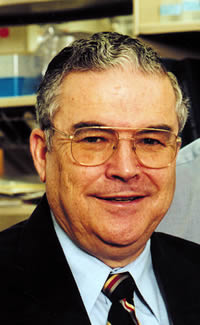
Missouri S&T has Ceramic Engineer inducted into the National Academy of Engineering
Dr. Delbert Day, Curators’ Professor Emeritus of Ceramic Engineering and Senior Investigator of the Materials Research Center, was inducted into the National Academy of Engineering this year. Dr. Day has worked in the area of ceramics for over 45 years. He served Missouri S&T as a professor, senior investigator of the Materials Research Center (MRC) and as the Director of MRC for many years. He has made many major contributions to science including a radioactive glass bead used in the treatment of liver cancer, treatments for rheumatoid arthritis, human bone repair, “glassphalt¿? recycling effort to put glass in asphalt for road repair, and co-founded Mo-Sci Corporation which manufactures specialty glass products used in electronics, coatings, and many other areas. He is currently the chairman and CEO of Mo-Sic Corp. Although Dr. Day is technically retired, he continues to run an active research program at Missouri S&T. We congratulate him on an exemplary career.
Technical Insights on Coatings Science Air temperature, humidity and movement can play an important roll as paint dries
Air movement usually has access to both the front and rear surface of the part. If the substrate is metal, heat is carried away by the solvent evaporating from the painted surface. Heat is being replaced from both the front surface and rear surface by the impact of air on the surface. Since metal is a good conductor of heat, the rear heating helps mitigate the heat loss and thus reduces the drop in temperature caused by evaporation. However, if the substrate is wood or plastic, the substrate does not conduct heat rapidly and the surface temperature falls much further since little heat transfer can occur from the rear. If the temperature drops below the dew point, condensation will occur. With solvents such as MEK or acetone, water may enter the coating to a significant extent even above the dew point. This is why both plastic and wood have more humidity problems when fast evaporating solvents are employed.
If moisture enters a solvent borne coating, it can precipitate the resin and flocculate the pigment causing obvious failure. If the coating is a reaction cure such as an epoxy or urethane, moisture can participate in the chemistry and reduce the cross-link density.
The air movement is both a help and a cause of problems. Relative humidity obviously is an issue since high humidity and a cooling film may result in condensation. For any test area or production facility, temperature and relative humidity as well as air velocity should be charted. Through charting, temperature, humidity and air velocity conditions can be controlled to produce an optimum window where the application will perform adequately.
THE COATINGS APPLICATOR: Is thin really in?
Many coatings are applied in relatively thick wet film thicknesses. Alternatively, the paint can be applied in several coats. Two major factors affect the outcome and success of this endeavor. The first is the rheology. If the coating is too low in viscosity, it may sag and thus limit the wet film thickness. The manufacturer can add a “thixotropic¿? additive to build the viscosity in such a way as to allow flow and leveling but prevent sag even at significant film thicknesses. However, a second factor that can change the outcome is the evaporation of the solvent. The coating is a dynamic event after application. In most cases the solvent must diffuse to the surface and evaporate. The thicker the paint, the longer this takes and solvents can become trapped within the coating as the surface skins over. The result can be a weaker coating. If the coating is reaction cure or air cures as in an alkyd, the interior may not cure properly and adhesive strength will suffer. In general, for solvent borne coatings such as epoxy, urethane, and alkyds, the thicker the film the weaker the adhesion. More thin coats avoid this by allowing the solvent to evaporate between coats; the chemistry functions better and for alkyds oxygen enters and the dryer catalyst blocking agent has a chance to leave. Thus the cure is much better and of higher strength. In general, one to three mil wet film thickness will produce good results for 50% solids by volume. For higher solids coatings, thinner wet films should be employed
Is there a topic you would like discussed? Contact us by e-mail at coatings@mst.edu. |

